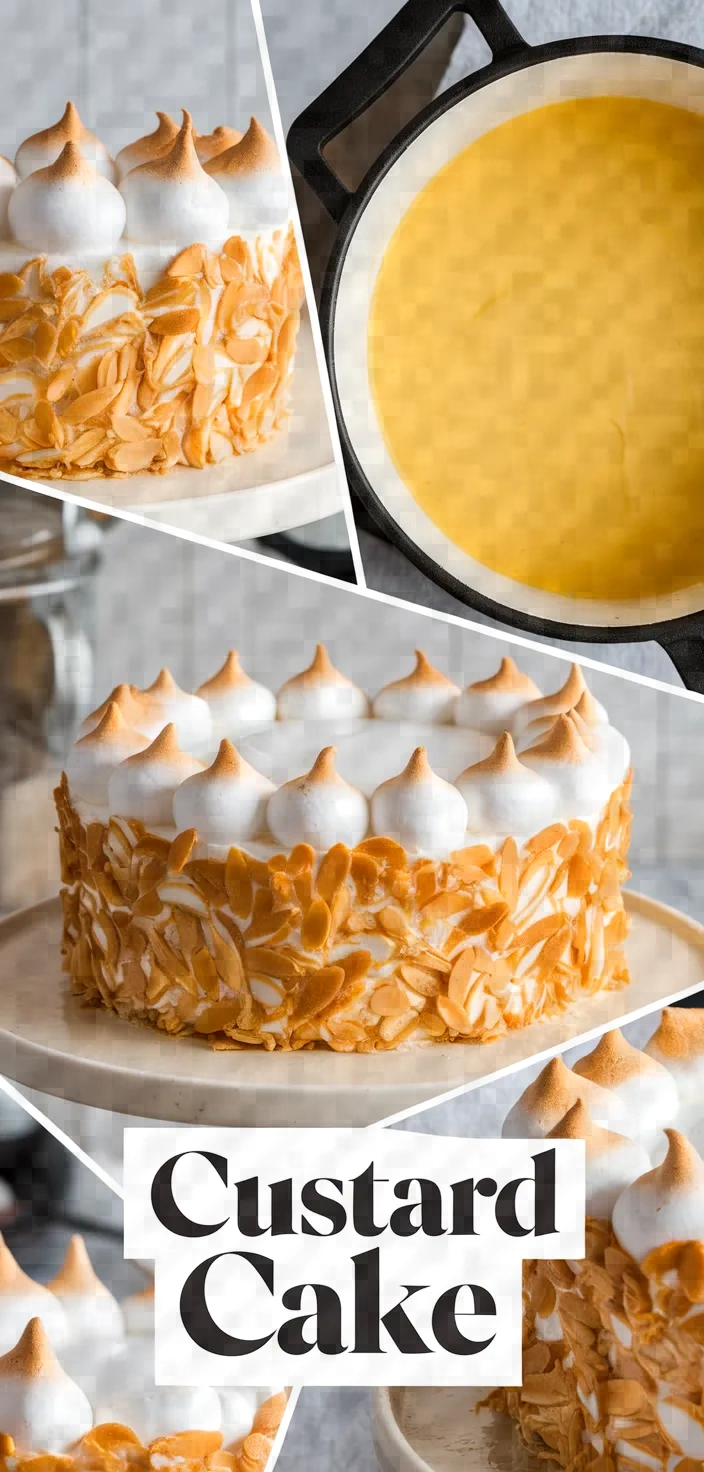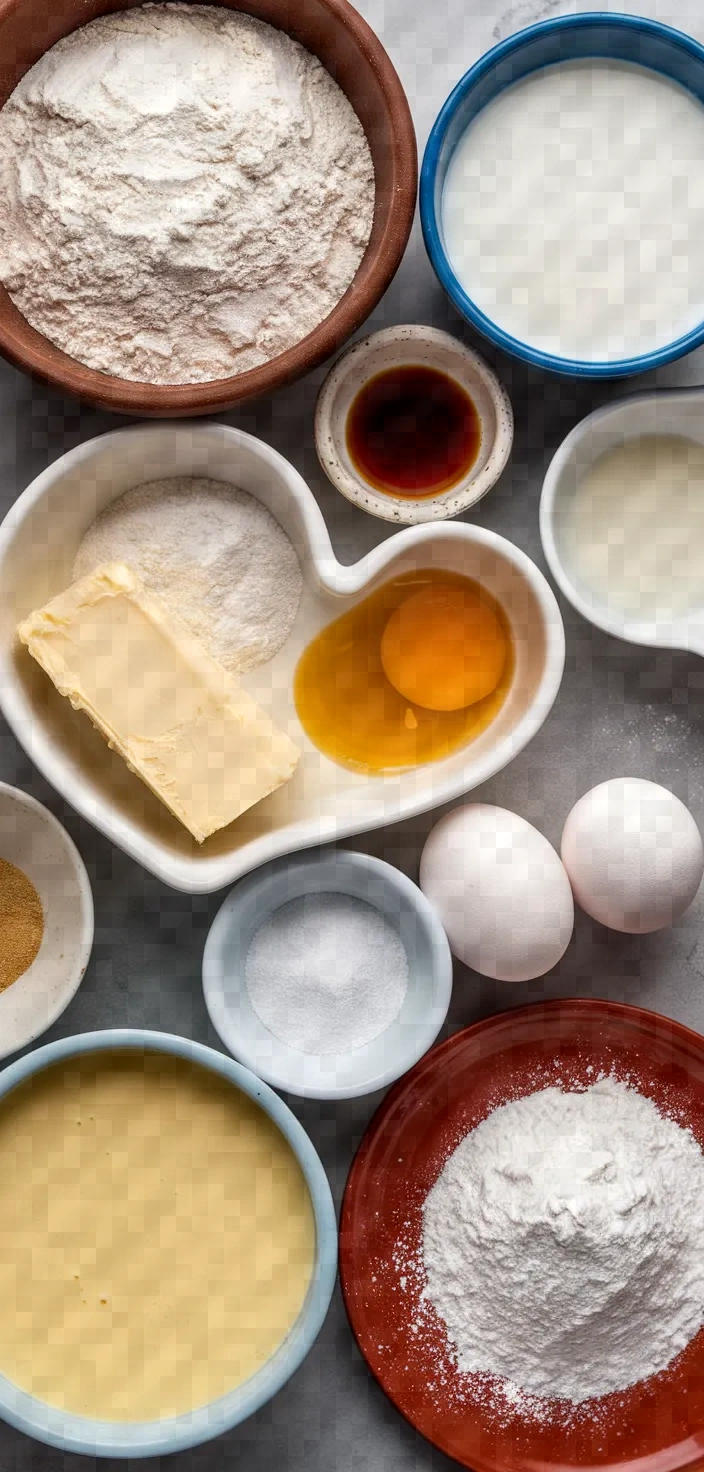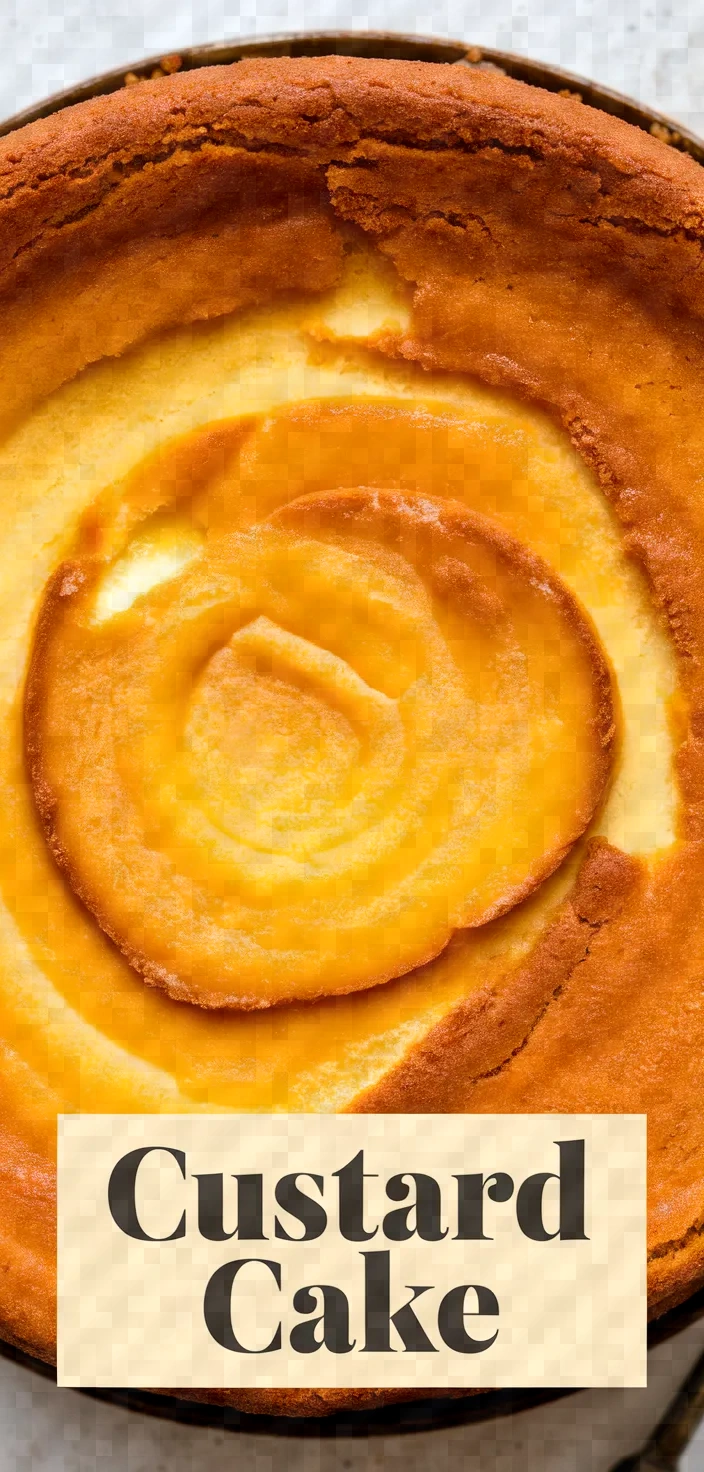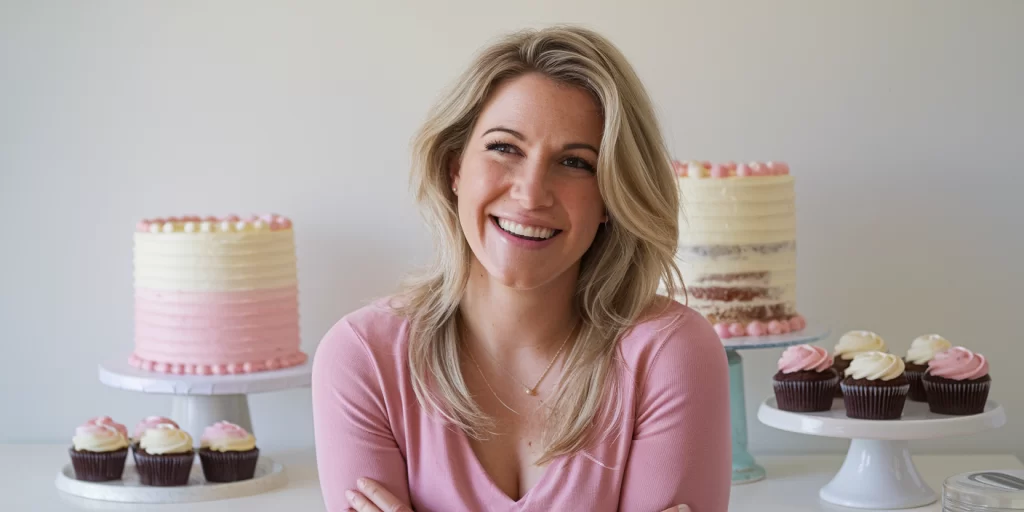Baking this cake feels like a nostalgic hug from my grandma’s kitchen, melding the simple pleasures of airy, cloud-like layers with a touch of vanilla warmth. There’s something so satisfying about transforming these familiar ingredients into a delicately golden, jiggle-topped masterpiece that’s as pleasing to the soul as it is to the eyes.

Custard Cake is a treat made from a delightful simplicity. Despite the cake’s delicate texture, the ingredients are anything but light: all-purpose flour, granulated sugar, and rich buttery goodness are the base of the cake.
And if you think vanilla is a fake flavor, you should try this recipe; it’s the best showcase for real vanilla extract I’ve ever encountered. The milk tones down the flavors and keeps them well-rounded.
Custard Cake Recipe Ingredients

- All-purpose flour: Provides structure, source of carbohydrates.
- Granulated sugar: Sweetens cake, caramelizes for color.
- Unsalted butter: Adds richness, moisture, and flavor.
- Vanilla extract: Enhances aroma, brings depth to flavor.
- Eggs: Balance texture, offer protein, aid leavening.
- Whole milk: Adds creaminess, moisture, and tenderness.
- Heavy cream: Enriches custard, adds luxurious texture.
- Cream of tartar: Stabilizes egg whites, improves consistency.
Custard Cake Recipe Ingredient Quantities
- 1 cup all-purpose flour
- 1 cup granulated sugar
- 1/2 cup unsalted butter, melted
- 1/4 cup milk
- 1 teaspoon vanilla extract
- 3 large eggs, separated
- 1/4 teaspoon cream of tartar
- 1 cup whole milk
- 1/2 cup heavy cream
- Pinch of salt
- Powdered sugar, for dusting
How to Make this Custard Cake Recipe
1. Set your oven to 325ºF (160ºC) to preheat. Use grease and parchment paper to prepare an 8-inch square pan for baking.
2. In a bowl, mix together the egg yolks and granulated sugar. Whisk them until they are light and fluffy. Then, in a very slow and steady stream, add the melted butter. Stir continuously as you add it so that the butter incorporates beautifully. You can be even more certain of that if you stir like it’s your last meal!
3. Blend the milk (1/4 cup) and the vanilla extract into the mixture to achieve a smooth consistency.
4. Gradually add the all-purpose flour, along with a pinch of salt, and mix just until smooth. It’s okay if you see a few small lumps in the batter.
5. In another bowl, beat the egg whites, along with the cream of tartar, until they hold their shape and are not going to collapse. They should look like really fluffy clouds or, in the baking world, stiff peaks.
6. Fold the shaken egg white thoroughly into the yolk mixture, being very careful not to deflate the egg white. Deflate the egg white and you will deflate the souffle.
7. In a different bowl, mix the whole milk and heavy cream, and then slowly add this to the batter, blending until everything is evenly mixed.
8. Place the batter in the pan that has been readied for baking. Smooth the top of the batter with a spatula. It is even more essential in this step, compared to the previous one, to make sure the batter is level. Uneven batter will yield an uneven cake. And a cake that has a weird top is just less aesthetically pleasing than a cake with a flat top.
9. Bake for 50-60 minutes, or until the top is a light golden brown, and the cake jiggles just a little when shaken.
10. Permit the cake to achieve a state of total coolness. Extract it from the pan, and give it a light coating of powdered sugar. Cut it into serving-sized pieces and present it.
Custard Cake Recipe Equipment Needed
1. Oven
2. 8-inch square baking pan
3. Parchment paper
4. Cooking spray or butter (for greasing)
5. Mixing bowls (at least 3)
6. Whisk
7. Spatula
8. Measuring cups
9. Measuring spoons
10. Hand mixer or stand mixer
11. Sifter (optional, for dusting powdered sugar)
FAQ
- Q: Can I use a different type of flour?A: For the best texture, all-purpose flour is recommended, but you can use cake flour for a lighter cake. Whole wheat flour is not a good choice—it will change both the flavor and texture in ways that most people won’t like.
- Q: Is it necessary to separate the egg whites and yolks?A: Yes, to get the airy and light texture of a custard cake, it is very necessary to separate the egg whites from the yolks and to beat the whites separately.
- Q: Can I substitute the cream of tartar?A: If you lack cream of tartar, use an equal quantity of lemon juice or white vinegar to stabilize your egg whites.
- Q: What alternatives can I use instead of unsalted butter?A: Salted butter can be used, but reduce the recipe’s salt. Margarine or a neutral oil may be used in its place, but this could alter the flavor somewhat.
- Q: How should I store the custard cake?A: Once the cake has cooled, keep the custard in an airtight container in the fridge for up to 3 days. Right before serving, dust the cake with the powdered sugar.
- Q: Can I add flavors or other ingredients?A: To give your custard a citrus note, you can add lemon or orange zest. Cinnamon or nutmeg can be incorporated for a spiced flavor. If you use spices, don’t incorporate too much in order to affect the custard setting adversely. And you should be careful with the amount of any additional liquid or wet ingredient that you might want to add.
Custard Cake Recipe Substitutions and Variations
1 cup all-purpose flour. Substitute with 1 cup cake flour for a lighter texture.
1 cup of granulated sugar: Substitute with 1 cup of superfine sugar for a bath that is fluffier and has a finer texture.
1/2 cup unsalted butter, melted: Substitute with 1/2 cup melted coconut oil.
1/4 cup milk: Substitute with 1/4 cup almond milk or soy milk for a non-dairy version.
1/4 cup almond milk or soy milk: Substitute with 1/4 cup milk for a version that has dairy in it.
Three large eggs, separated. Substitute with 3/4 cup silken tofu, blended, as a vegan alternative to eggs. Note: Texture and taste might differ.
Pro Tips
1. Room Temperature Eggs: Ensure your eggs are at room temperature before separating them. This helps create a more stable meringue when you’re beating the egg whites, which will fold more smoothly into the batter.
2. Incorporate Flour Gently: When adding the flour to the egg yolk mixture, use a sifter to prevent clumps and to incorporate it gently. This will help maintain a light texture in the final cake.
3. Stiff Peaks Perfection: When beating the egg whites, ensure you reach stiff peaks but not beyond that point to avoid drying them out. The peaks should stand up straight when you lift the beaters.
4. Slow Fold Technique: Use a spatula to fold the egg whites into the batter gently. Cut through the center and scoop around the sides of the bowl, rotating the bowl as you go. This helps maintain as much air in the mixture as possible.
5. Cooling Gradually: Once baked, let the cake cool in the pan first before gently removing it. This will help prevent the cake from collapsing as it adjusts from the hot oven to a cooler room temperature.

Custard Cake Recipe
My favorite Custard Cake Recipe
Equipment Needed:
1. Oven
2. 8-inch square baking pan
3. Parchment paper
4. Cooking spray or butter (for greasing)
5. Mixing bowls (at least 3)
6. Whisk
7. Spatula
8. Measuring cups
9. Measuring spoons
10. Hand mixer or stand mixer
11. Sifter (optional, for dusting powdered sugar)
Ingredients:
- 1 cup all-purpose flour
- 1 cup granulated sugar
- 1/2 cup unsalted butter, melted
- 1/4 cup milk
- 1 teaspoon vanilla extract
- 3 large eggs, separated
- 1/4 teaspoon cream of tartar
- 1 cup whole milk
- 1/2 cup heavy cream
- Pinch of salt
- Powdered sugar, for dusting
Instructions:
1. Set your oven to 325ºF (160ºC) to preheat. Use grease and parchment paper to prepare an 8-inch square pan for baking.
2. In a bowl, mix together the egg yolks and granulated sugar. Whisk them until they are light and fluffy. Then, in a very slow and steady stream, add the melted butter. Stir continuously as you add it so that the butter incorporates beautifully. You can be even more certain of that if you stir like it’s your last meal!
3. Blend the milk (1/4 cup) and the vanilla extract into the mixture to achieve a smooth consistency.
4. Gradually add the all-purpose flour, along with a pinch of salt, and mix just until smooth. It’s okay if you see a few small lumps in the batter.
5. In another bowl, beat the egg whites, along with the cream of tartar, until they hold their shape and are not going to collapse. They should look like really fluffy clouds or, in the baking world, stiff peaks.
6. Fold the shaken egg white thoroughly into the yolk mixture, being very careful not to deflate the egg white. Deflate the egg white and you will deflate the souffle.
7. In a different bowl, mix the whole milk and heavy cream, and then slowly add this to the batter, blending until everything is evenly mixed.
8. Place the batter in the pan that has been readied for baking. Smooth the top of the batter with a spatula. It is even more essential in this step, compared to the previous one, to make sure the batter is level. Uneven batter will yield an uneven cake. And a cake that has a weird top is just less aesthetically pleasing than a cake with a flat top.
9. Bake for 50-60 minutes, or until the top is a light golden brown, and the cake jiggles just a little when shaken.
10. Permit the cake to achieve a state of total coolness. Extract it from the pan, and give it a light coating of powdered sugar. Cut it into serving-sized pieces and present it.










